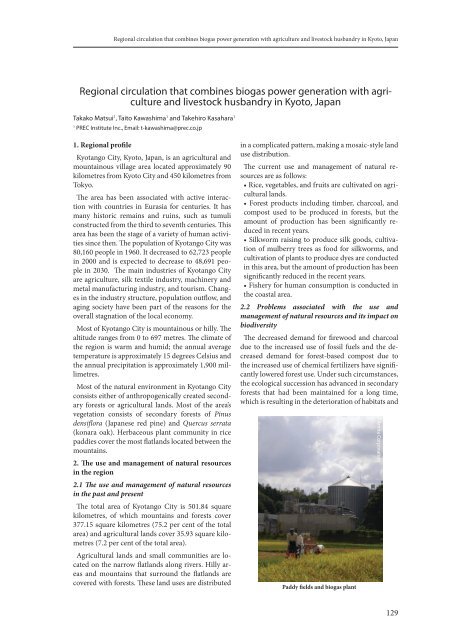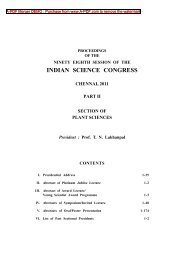sustainable use of biological diversity.pdf - India Environment Portal
sustainable use of biological diversity.pdf - India Environment Portal
sustainable use of biological diversity.pdf - India Environment Portal
You also want an ePaper? Increase the reach of your titles
YUMPU automatically turns print PDFs into web optimized ePapers that Google loves.
Regional circulation that combines biogas power generation with agriculture and livestock husbandry in Kyoto, Japan<br />
Regional circulation that combines biogas power generation with agriculture<br />
and livestock husbandry in Kyoto, Japan<br />
Takako Matsui 1 , Taito Kawashima 1 and Takehiro Kasahara 1<br />
1<br />
PREC Institute Inc., Email: t-kawashima@prec.co.jp<br />
1. regional pr<strong>of</strong>ile<br />
Kyotango City, Kyoto, Japan, is an agricultural and<br />
mountainous village area located approximately 90<br />
kilometres from Kyoto City and 450 kilometres from<br />
Tokyo.<br />
The area has been associated with active interaction<br />
with countries in Eurasia for centuries. It has<br />
many historic remains and ruins, such as tumuli<br />
constructed from the third to seventh centuries. This<br />
area has been the stage <strong>of</strong> a variety <strong>of</strong> human activities<br />
since then. The population <strong>of</strong> Kyotango City was<br />
80,160 people in 1960. It decreased to 62,723 people<br />
in 2000 and is expected to decrease to 48,691 people<br />
in 2030. The main industries <strong>of</strong> Kyotango City<br />
are agriculture, silk textile industry, machinery and<br />
metal manufacturing industry, and tourism. Changes<br />
in the industry structure, population outflow, and<br />
aging society have been part <strong>of</strong> the reasons for the<br />
overall stagnation <strong>of</strong> the local economy.<br />
Most <strong>of</strong> Kyotango City is mountainous or hilly. The<br />
altitude ranges from 0 to 697 metres. The climate <strong>of</strong><br />
the region is warm and humid; the annual average<br />
temperature is approximately 15 degrees Celsius and<br />
the annual precipitation is approximately 1,900 millimetres.<br />
Most <strong>of</strong> the natural environment in Kyotango City<br />
consists either <strong>of</strong> anthropogenically created secondary<br />
forests or agricultural lands. Most <strong>of</strong> the area’s<br />
vegetation consists <strong>of</strong> secondary forests <strong>of</strong> Pinus<br />
densiflora (Japanese red pine) and Quercus serrata<br />
(konara oak). Herbaceous plant community in rice<br />
paddies cover the most flatlands located between the<br />
mountains.<br />
2. The <strong>use</strong> and management <strong>of</strong> natural resources<br />
in the region<br />
2.1 The <strong>use</strong> and management <strong>of</strong> natural resources<br />
in the past and present<br />
The total area <strong>of</strong> Kyotango City is 501.84 square<br />
kilometres, <strong>of</strong> which mountains and forests cover<br />
377.15 square kilometres (75.2 per cent <strong>of</strong> the total<br />
area) and agricultural lands cover 35.93 square kilometres<br />
(7.2 per cent <strong>of</strong> the total area).<br />
Agricultural lands and small communities are located<br />
on the narrow flatlands along rivers. Hilly areas<br />
and mountains that surround the flatlands are<br />
covered with forests. These land <strong>use</strong>s are distributed<br />
in a complicated pattern, making a mosaic-style land<br />
<strong>use</strong> distribution.<br />
The current <strong>use</strong> and management <strong>of</strong> natural resources<br />
are as follows:<br />
• Rice, vegetables, and fruits are cultivated on agricultural<br />
lands.<br />
• Forest products including timber, charcoal, and<br />
compost <strong>use</strong>d to be produced in forests, but the<br />
amount <strong>of</strong> production has been significantly reduced<br />
in recent years.<br />
• Silkworm raising to produce silk goods, cultivation<br />
<strong>of</strong> mulberry trees as food for silkworms, and<br />
cultivation <strong>of</strong> plants to produce dyes are conducted<br />
in this area, but the amount <strong>of</strong> production has been<br />
significantly reduced in the recent years.<br />
• Fishery for human consumption is conducted in<br />
the coastal area.<br />
2.2 Problems associated with the <strong>use</strong> and<br />
management <strong>of</strong> natural resources and its impact on<br />
bio<strong>diversity</strong><br />
The decreased demand for firewood and charcoal<br />
due to the increased <strong>use</strong> <strong>of</strong> fossil fuels and the decreased<br />
demand for forest-based compost due to<br />
the increased <strong>use</strong> <strong>of</strong> chemical fertilizers have significantly<br />
lowered forest <strong>use</strong>. Under such circumstances,<br />
the ecological succession has advanced in secondary<br />
forests that had been maintained for a long time,<br />
which is resulting in the deterioration <strong>of</strong> habitats and<br />
paddy fields and biogas plant<br />
© Amita Corporation<br />
129
















